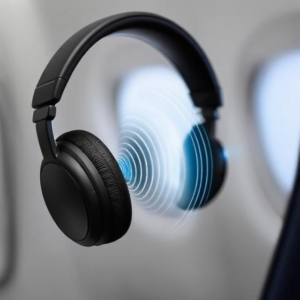What is Active Noise Cancellation (ANC)?
Active Noise Cancellation is a technology used to reduce unwanted sounds, like background noise, by using sound waves that cancel out the noise. This is usually found in devices like headphones or earbuds that help block out sounds from the environment, like people talking or engine noise on a plane.

How Does ANC Work?
ANC uses a special circuit to generate a sound wave that is the opposite (or “anti-phase”) of the unwanted noise. When the “anti-noise” wave meets the unwanted noise wave, they cancel each other out. This makes the sound much quieter or sometimes completely gone.
Here’s how the ANC system works step-by-step:
- Microphone Picks Up Noise:
- The ANC system has small microphones built into the device (like the headphones). These microphones listen to the sounds in the environment (like traffic noise or a hum from a plane).
- Creating the Anti-Noise:
- The microphone sends the detected noise to a digital signal processor (DSP) inside the ANC circuit. The DSP analyzes the noise and then creates a sound wave that is the exact opposite of the detected noise. This opposite wave is called anti-noise.
- Speaker Emits Anti-Noise:
- The ANC system sends this anti-noise to the speaker in the headphones. When the anti-noise sound wave is played, it meets the original unwanted noise, and the two waves cancel each other out.
- Noise is Reduced or Cancelled:
- The result is that the unwanted noise is reduced, and you hear less of it, or even none at all. This is how the ANC headphones make your surroundings quieter, even though they might not block out the sound physically.
Key Parts of ANC Circuits:
- Microphone:
- This picks up the ambient noise (the unwanted sound).
- Signal Processor (DSP):
- This processes the noise signal and generates the opposite sound wave (anti-noise).
- Amplifier:
- The amplifier boosts the anti-noise signal so that it can be played through the speaker.
- Speaker:
- The speaker emits the anti-noise sound wave that cancels out the unwanted sound.
Types of Noise Cancellation:
- Active Noise Cancellation (ANC): Uses the method described above (microphone, processor, anti-noise) to cancel out noise.
- Passive Noise Cancellation: Doesn’t use electronics to cancel noise. It relies on the physical design of the headphones (like ear pads) to block out sound by creating a seal around your ears.
Advantages of Active Noise Cancellation:
- Better Noise Reduction: ANC is much more effective at reducing continuous noises like engine sounds, air conditioning, or crowds.
- Improved Listening Experience: When the noise is reduced, you can hear your music or podcast more clearly, even at lower volumes.
- Comfort: ANC headphones can help reduce the need to turn up the volume to block out background noise, which is better for your ears.
Challenges with ANC:
- Not Perfect for All Types of Noise: ANC works best for low-frequency, constant noises (like a hum or buzz). It’s not as effective at cancelling out irregular, sharp noises (like someone talking or sudden bangs).
- Battery Power: Since ANC requires power to operate the microphones and processors, the headphones or earbuds need to be charged regularly.
- Cost: ANC technology adds extra cost to headphones, so they tend to be more expensive than regular headphones.
Conclusion:
Active Noise Cancellation (ANC) circuits are a clever way to reduce unwanted background noise by using sound waves that cancel out the noise. This makes devices like headphones and earbuds great for people who want to enjoy music or focus in noisy environments. The system works by picking up ambient noise with microphones, processing the sound, and generating an opposite wave that cancels out the noise.
Tags: active noise cancellation, active noise cancelling circuits., advantages of ANC, amplifier in ANC system, ANC circuits, ANC for headphones and earbuds, ANC system components, ANC technology, anti-noise wave, background noise reduction, battery life ANC headphones, challenges of ANC technology, constant noise cancellation, cost of ANC headphones, digital signal processor ANC, DSP in noise cancellation, Electronics, how ANC works, improved listening experience ANC, low frequency noise cancellation, microphone in ANC, noise cancelling audio devices, noise cancelling earbuds, noise cancelling headphones, noise reduction technology, passive noise cancellation vs active, speaker anti-noise emission, types of noise cancellation


